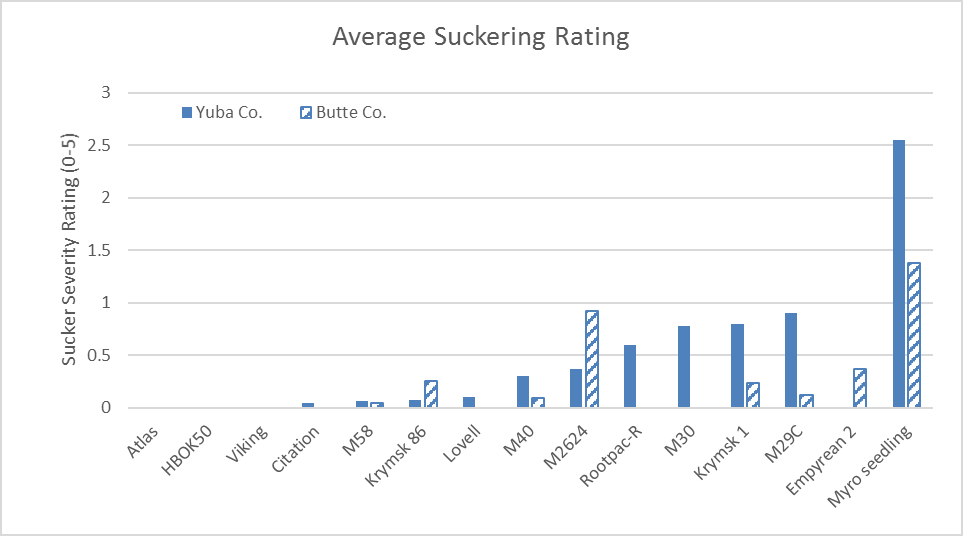By: Rich Buchner, Franz Niederholzer, Katherine Jarvis-Shean, UCCE Farm Advisors, and Chuck Fleck, Sierra Gold Nursery.
Roots are the unsung heroes of orchard plantings. They operate out of sight and are relatively difficult to ex-amine and characterize. So what do roots do?
Roots:
-Anchor trees to the soil
-Take up water and essential mineral elements for use by the entire tree
-Store carbohydrates and synthesize materials
Rootstocks:
-Influence scion vigor, growth and performance
-Have varying tolerance to different soil types and conditions
-Have varying resistance to soil borne diseases/nematodes
-Must be graft compatible with the scion variety
The root system is a branching system of main roots, lateral roots, feeder roots, and root hairs. The root hairs are the primary uptake structures. Healthy roots require aeration which is why over irrigation is detrimental to root performance. Low oxygen and high carbon dioxide reduce or stop root growth. Low soil moisture and temperature will also stop root growth.
The California prune industry has primarily utilized five rootstocks: Myrobalan Seedling, Myrobalan 29C, Marianna 2624, Lovell Peach and Marianna 40. The characteristics of these rootstocks are listed in the root-stock chapter of the Prune Production Manual (ANR #3507). Many more potential rootstocks for prune are being investigated. Three prune rootstock experiments evaluating 29 rootstocks are planted in Northern California. One experiment was planted at the UC Davis Wolfskill Experimental Orchards on 1/19/2011 (Yolo loam), a second experiment was planted in Yuba County on 6/3/2011 (Kilaga clay loam over hardpan) and a third experiment in Butte County was planted on 4/28/2011 (Farwell clay adobe alternated with Nord loam). All trees were nursery grafted to the ‘Improved French’ variety. Fowler Nursery donated most of the trees, with Viking and Atlas rootstock donations from Dave Wilson Nursery and HBOK 50 from Duarte Nursery. The first commercial harvest took place in 2015.

Figure 1. Comparison of average sucker rating per rootstock for the Butte and Yuba County experiments. Suckers were rated 0 to 5, with 5 as most severe.
Figures 1-2 summarize the anchorage and suckering for the Butte Co. and Yuba Co. plots. Results from the Wolfskill site have not been given because it is a non-replicated ‘first look’ trial with many unusual rootstocks. Results on yield and size are not presented here because interpretation is complicated by different rootstocks having different numbers of replants at different sites. As trees fill in, yield and size will be reported in the future. The complete report can be found at the UC Davis Fruit and Nut Research and Information Center website.

Figure 2. Leaning measurements for the Butte and Yuba County rootstock experiments. Measurements recorded degrees of deflection from vertical when pushing on the tree trunk. Higher numbers mean greater lean or poorer anchorage. Yuba County was measured shortly after irrigation and may be higher as a result.
Although all of these results are preliminary, we will be closely watching to see if trends begin to develop. One possible trend to watch for is the similarity of anchorage and suckering rankings between the Butte and Yuba rootstock sites. Krymsk 86 and Viking had among the best anchorage and suckering scores (least deflection and lowest suckering, respectively) at both sites. Krymsk 1 and M58 which were among the highest yielding at both sites (data not shown) also had the worst anchorage. In the Butte plot, summer observations confirm poor growth and performance for Krymsk 1 and HBOK 50 suggesting they will not be candidates for commercial adoption. We will continue to report on these trials as the trees mature.


Leave a Reply